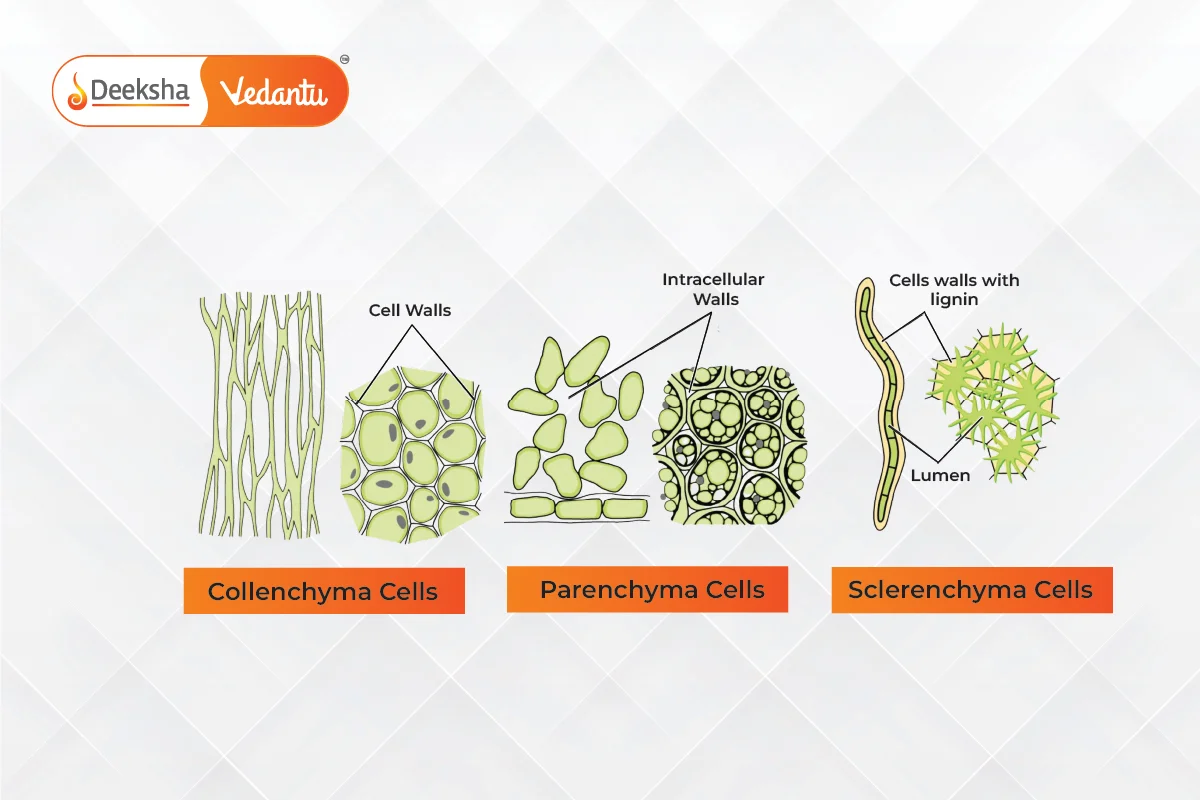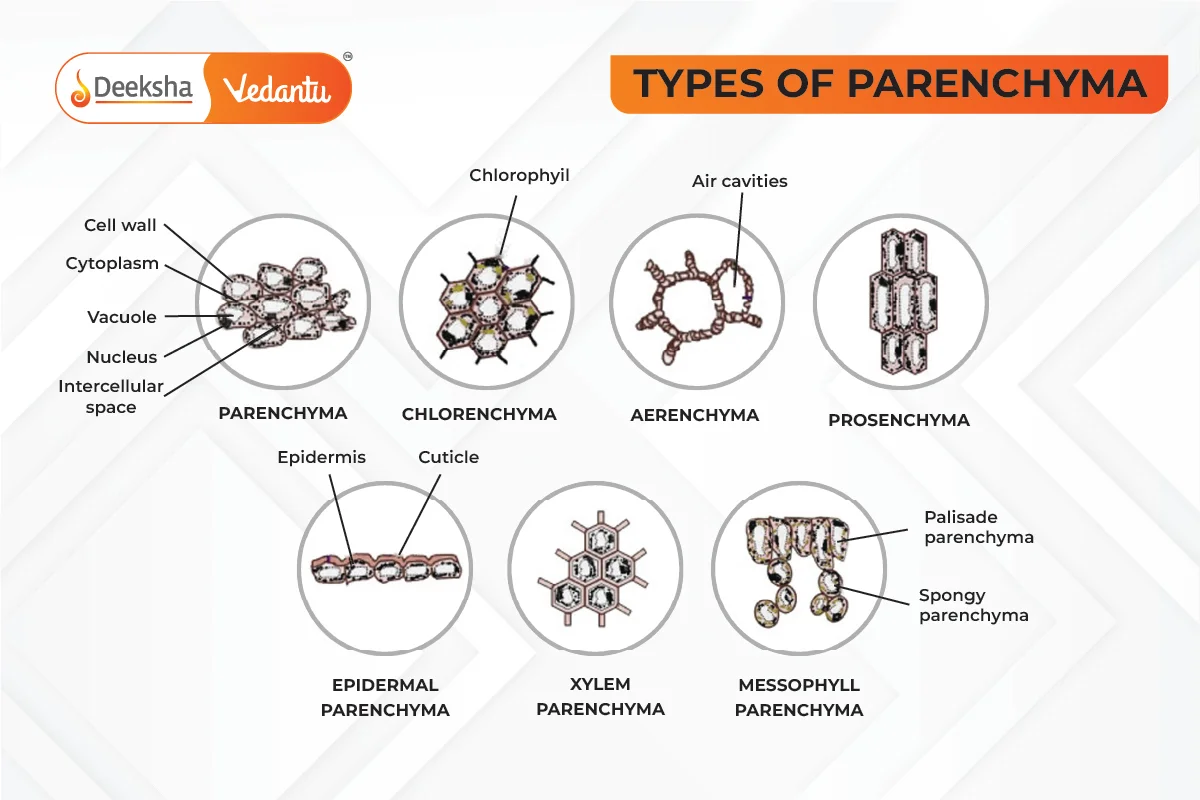Parenchyma is a fundamental type of simple permanent tissue in plants, forming a major part of the ground tissues where vascular tissues are embedded. These tissues are non-vascular, consisting of simple, living, and undifferentiated cells, which adapt to perform a variety of functions.

Other types of simple permanent tissues include:
- Collenchyma
- Sclerenchyma
Main Characteristics of Parenchyma
- Living Tissue: Parenchyma cells are living and retain the ability to divide even at maturity, contributing to regeneration and wound healing.
- Foundation of Plant Cells: Parenchyma cells serve as the foundation for reproductive cells (spores and gametes).
- Totipotency: A single parenchyma cell, such as a zygote, can develop into an entire plant, demonstrating totipotency.
- Continuous Masses: These cells form continuous masses in the pith, cortex of stems and roots, mesophyll of leaves, flesh of fruits, and endosperm of seeds.
- Heterogeneous Complex Tissues: They can combine with other cells to form complex tissues, like parenchyma in xylem and phloem.
- Functional Diversity: Parenchyma cells are vital for photosynthesis, storage, secretion, assimilation, respiration, excretion, and radial transport of water and solutes.
Structure of Parenchyma Cells
- Living Cells: They have a prominent nucleus and protoplast.
- Shape: Parenchyma cells can be isodiametric, polyhedral, polygonal, oval, round, or elongated.
- Cell Wall: Composed of cellulose and hemicellulose, sometimes lignified.
- Intercellular Space: These cells may be closely packed or have small intercellular spaces.
- Plasmodesmata: Connects parenchyma cells.
- Vacuoles: Young cells have several small vacuoles, which merge into a large central vacuole in older cells.
- Water Reservoir: Vacuoles store water.
- Thick Walls: Some storage parenchyma cells have thick walls, e.g., in the endosperm of date palms.
- Chromoplasts: Present in the parenchyma cells of flowers and fruits.
- Chloroplasts: Specialized cells for photosynthesis.
- Dense Protoplasm: Cells performing secretory functions have dense protoplasm rich in ribosomes, Golgi bodies, and endoplasmic reticulum.
Types of Parenchyma Cells

Parenchyma cells are categorized based on structure, location, and function:
- Chlorenchyma: Contains chloroplasts for photosynthesis. Found in mesophyll cells of leaves and other green parts like stems and sepals.
- Transfer Cells: Facilitate solute transport over short distances. Found in absorption and secretion areas like nectaries and salt glands.
- Vascular Parenchyma: Associated with vascular tissues.
- Phloem Parenchyma: Stores food and other substances, absent in monocots.
- Xylem Parenchyma: Stores food materials and assists in radial water conduction.
- Storage Parenchyma: Stores substances like water, starch, and proteins. Found in potato tubers, endosperm of cereals, and cotyledons.
- Prosenchyma: Elongated, thick-walled cells providing rigidity and strength.
- Aerenchyma: Contains large intercellular spaces, aids buoyancy in aquatic plants, and helps in respiration by providing oxygen to submerged tissues.
- Epidermis Parenchyma: Found in the epidermis of some gymnosperms, reduces transpiration.
- Conjunctive Parenchyma: Present in the root system, absorbs water and minerals.
Functions of Parenchyma Cells
Parenchyma cells perform various essential functions in plants:
- Storage: Ideal for storing water, fats, oils, starch, and ergastic substances.
- Transport: Involved in nutrient and chemical transport, absorption, and radial water transport.
- Photosynthesis: Chlorenchyma cells in mesophyll perform photosynthesis.
- Gas Exchange: Aerenchyma cells facilitate gas exchange.
- Protection: Spiny projections in some parenchyma cells protect against predators.
- Totipotency: Capable of transforming into other cell types, acting as precursors.
- Buoyancy: Aerenchyma in aquatic plants aids in floating.
- Mechanical Strength: Thick-walled parenchyma cells provide mechanical support.
- Healing and Regeneration: Aid in wound healing and regeneration, and protect vascular tissues in drought conditions.
FAQs
Aerenchyma cells have large intercellular spaces that facilitate buoyancy and gas exchange, allowing aquatic plants to float and maintain sufficient oxygen levels for respiration.
Parenchyma cells retain their ability to divide even at maturity, which helps in wound healing and regeneration of plant tissues.
Types of parenchyma cells include chlorenchyma, transfer cells, vascular parenchyma, storage parenchyma, prosenchyma, aerenchyma, epidermis parenchyma, and conjunctive parenchyma.
Parenchyma cells are involved in storage, transport of nutrients and water, photosynthesis, gas exchange, protection, buoyancy, mechanical support, and healing and regeneration.
Parenchyma cells are found throughout the plant in the pith, cortex of stems and roots, mesophyll of leaves, flesh of fruits, and endosperm of seeds.
Parenchyma cells are living, undifferentiated cells that make up a significant portion of ground tissue in plants, performing various essential functions such as storage, photosynthesis, and regeneration.
Related Topics
- Important Notes For NEET Biology -Shapes of Bacteria
- What is Hemoglobin
- Important Notes For NEET Biology – Body Fluids and Circulation
- Important Notes For NEET Biology – Anatomy of Flowering Plants
- NEET Biology Weightage
- Plasmid
- Connective Tissue
- Important Notes For NEET Biology – Morphology of Flowering Plants
- Important Notes For NEET Biology – The Living World
- Plant Hormones
- Bryophytes
- Important Notes For NEET Biology – Breathing and Exchange of Gases
- Euglena
- Marchantia
- Important Notes For NEET Biology – Cell Cycle and Cell Division







Get Social